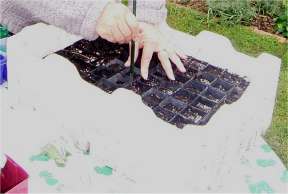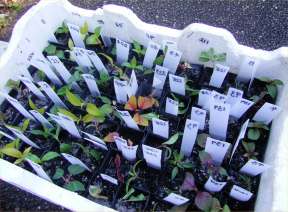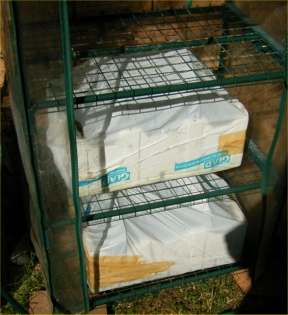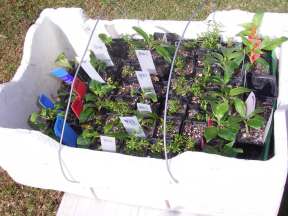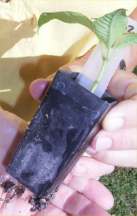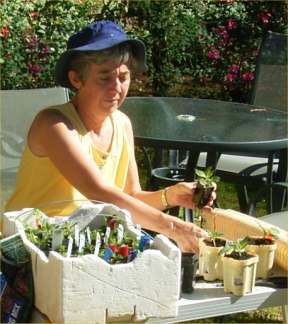Propagation
·
2020 Fuchsia sale ONLY, NO open garden, click Open Fuchsia Garden for more details.
Join us on Facebook http://www.facebook.com/groups/394140627308376/
|
Pages updated Feb 2020. |
I no longer use this method as I now have a greenhouse with heatmats. Several people I know do use this method .
|
Preparing the tubes to receive the cuttings use a short cane to make holes never push the cutting into the mix.
Cuttings ready to be sealed for 6 weeks
The boxes after wire has been inserted and bags sealed |
I
use modified from information given to me in Adelaide by a member of the
Australian Fuchsia Society. With this method I have a 90-99% success rate in
spring and autumn. I use tip cuttings cut directly below the second node or if not much growth is available just below the first node using a sharp pair if stainless steel scissors. When the cutting pieces from plants cut just above a node then trim your cutting afterwards. If you leave stalk above the node on the plant this section will die off and be prone to disease.
The cuttings are planted in tubes in a polystyrene box the propagating mix is 50% river sand (I now substitute this with 25% perlite) 50% potting mix. Tip cuttings are used, ensuring the leaves don't touch each other or the tubes or the box. The cuttings are watered in, then the whole box is put in a white kitchen tidy bag , wire similar to coat hanger wire is inserted to hold the plastic off the cuttings then it is sealed thoroughly. Then left in a warm light position out of the sun for 6 weeks. Check every 10 days for mould and spray with an anti-fungal if necessary, re-seal immediately. They should be well rooted after 6 weeks, with the roots coming out the bottom of the tubes. Re-pot into 4 inch pots not disturbing the mix around the roots. As I used to work full time, not having to worry about them for 6 weeks is a big plus and the success rate a definite advantage. If you don't want to do a whole box full of cuttings fill up the space with empty pots so the tubes can't fall over. I have been asked "what is a Polystyrene box? By a Northern hemisphere grower and why 6 weeks? So here is a more detailed description. A polystyrene box is what lots of fruit and vegetables come in here. It is 48 x 30 cm and fits 50-70 tubes in depending on their size. The fruit and vegetable shops usually send them back to the market but will usually give or sell them to customers. They are of about 3cm thick polystyrene and this seems to insulate the cuttings. It usually takes about 6 weeks to get reasonable roots in my small plastic greenhouse - I haven't used plastic bags before. This method using a large 75 x 55cm bag that is white translucent plastic. In the 6 weeks the tube is full of very healthy vigorous roots and they are coming through the base of the tube. They pot on readily and don't usually suffer a setback. I know it contradicts most books but it works - try it if you can get the boxes and see what you think |
|
After 6 weeks the plastic is removed, here cuttings including encliandras and Bolivianna have rooted well and are ready for re-potting. This photo also shows the wire used to keep plastic off cuttings. |
Showing the root development at 6 weeks, note root coming out of bottom |
Here I am potting on the cuttings on the left. |
If you are only do a few cuttings a pot covered in a plastic bag supported with wire or half a soft drink bottle as a "dome" works well. Whatever method you use keep them moist but not wet and locate them in a warm light position but not in direct sunlight.
o Constructing a Fuchsia Garden
o Growing standard and pillar Fuchsias
o Growing Fuchsias in the ground PDF print-friendly version
o Pruning
o Where to buy Fuchsias in Australia
§ Meetings
open garden in 2016 here for more details
